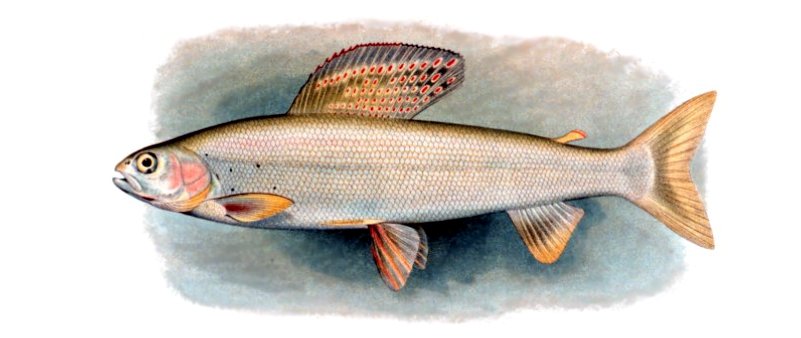- Grayling (genus)
Taxobox
name = "Thymallus"
fossil_range =Pleistocene to Present [cite journal
last = Sepkoski
first = Jack
authorlink =
coauthors =
title = A compendium of fossil marine animal genera
journal = Bulletins of American Paleontology
volume = 364
issue =
pages = p.560
publisher =
location =
date = 2002
url = http://strata.ummp.lsa.umich.edu/jack/showgenera.php?taxon=611&rank=class
doi =
id =
accessdate = 2008-01-07 ]

image_width = 250px
image_caption =Arctic grayling ("T. arcticus arcticus")
regnum =Animal ia
phylum =Chordata
classis =Actinopterygii
ordo =Salmoniformes
familia =Salmonidae
subfamilia = Thymallinae
genus = "Thymallus"
genus_authority = Linck, 1790
subdivision_ranks =Species
subdivision =
"(see text)""Thymallus" is a
genus offreshwater fish in thesalmon family (familySalmonidae ) of orderSalmoniformes ; it is the only genus ofsubfamily Thymallinae. Thetype species is "T. thymallus," thegrayling . The genus's five distinctspecies are generically called graylings, but without qualification this also refers specifically to "T. thymallus."The fishes of this genus are native to the northern parts of the
Nearctic andPalearctic ecozone s, ranging from theUnited Kingdom and northernEurope acrossEurasia toSiberia , as well as northernNorth America . "T. thymallus," the grayling proper, is widespread in Europe, and "T. arcticus arcticus," the Arctic grayling, is widespread throughout Eurasia east of theUral Mountains and in the Nearctic. The other species and "T. arcticus"subspecies have more localized ranges.The "Thymallus" species are distinguished from other members of the
salmon family by their larger scales, their small mouths withteeth on themaxillary bone, and most striking of all, their showy, sail-likedorsal fin s. This fin is longer in males and highly colourful, with spots of red, orange, purple or green. The body is also colourful; the dorsal surface is a dark purplish to bluish black or gray, grading to dark blue or silver gray on the flanks and gray or white on the belly. The body is further decorated with a smattering of small dark spots; these are much more numerous in juveniles. The largest of the graylings in terms of length is theArctic grayling ("T. arcticus arcticus") at a maximum length of 76 cm (30 in) and a maximum weight of 3.8 kg (8.4 lb); other subspecies of "T. arcticus" are typically half this length or less. The grayling proper, "T. thymallus," while somewhat shorter - 60 cm (24 in) - may weigh significantly more, 6.7 kg (15 lb).The fishes of this genus may live for 18 years or more.As they are highly sensitive to changes in water quality, "Thymallus" fishes may be considered
indicator species ; "T. arcticus arcticus" has largely disappeared from theGreat Lakes Basin . These fishes require cool, well-oxygenated water, preferably with a swift current; they are found in large sandy- or gravelly-bottomed rivers and lakes, but "T. thymallus" may occasionally be found inbrackish conditions. Generallyomnivorous , they feed primarily oncrustaceans ,insects , andzooplankton .The grayling species, typically for salmonids, spawn in rivers and do not guard their brood, although they do conceal their eggs in silt. The spawning behavior of the
Arctic grayling may be typical for the "Thymallus" species.Due to their agreeable taste and attractive form, the grayling species are valued as food and game fishes, and they are occasionally seen in public
aquaria . The most economically important of these fishes, for which fisheries andaquaculture operations exist, are theArctic grayling ("T. arcticus arcticus") and thegrayling proper ("T. thymallus").The generic name "Thymallus" derives from the Greek "θύμαλλος," a name for the grayling.
Franz Steindachner (1834-1919) classified theAdriatic trout ("Salmo obtusirostris") as "Thymallus microlepis," but that name is not considered valid.Species
*"T. arcticus:"
**"T. arcticus arcticus" – Arctic grayling
**"T. arcticus baicalensis" – Baikal black grayling
**"T. arcticus mertensii"
**"T. arcticus pallasi" – East Siberian grayling
*"T. brevirostris" – Mongolian grayling
*"T. grubii" – Amur grayling
*"T. nigrescens" – Kosogol grayling
*"T. thymallus" – Grayling
*"T. tugarinae"
*"T. yaluensis"References
*
*
Wikimedia Foundation. 2010.
